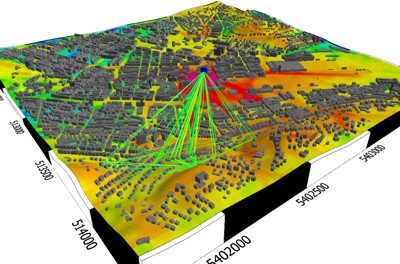Propagation Models
The design and implementation of personal communication systems requires the prediction of wave propagation relating to signal-to-noise and signal-to-interference calculation in a cellular system. Small cell network configurations – especially micro and pico cell types – are of major interest for urban environments because of the increasing capacity demands.
The commonly used criterion for the definition of a micro cell is related to the height of the base station antenna. For a typical micro cell the base station antenna height is below the average rooftop level of the surrounding buildings or about the same height. Thus the resulting cell radius is in the range of 250-500m. A further characteristic is the low transmitting power. However, a prediction range up to several kilometers has to be regarded for inter-cellular interference calculations. A pico cell base station is usually installed inside a building providing coverage also outside around the building.

Figure 1. An urban propagation scenario.
Radio transmission in urban environments is subject to strong multipath propagation. Dominant characteristics in these scenarios are reflection, diffraction, shadowing by discrete obstacles and the wave guiding in street canyons. To consider these effects in a propagation model, it is necessary to gain knowledge of all dominant propagation paths. These paths depend primarily on the base station antenna height with respect to the building heights around.
For simplification of propagation modeling several two dimensional empirical models have been developed under the assumption of over-rooftop propagation as main propagation mechanism. The model according to Walfisch-Ikegami with extensions from the European research cooperation COST 231 is such an analytical approach with empirically based equations and correction factors.
The second group of micro-cellular prediction models are deterministic and use ray optical methods. They allow a very site-specific, three dimensional path loss and signal spread prediction including impulse response for base station heights below as well as above rooftop level. Hence, a three dimensional description for the propagation environment including building shape and building heights has to be incorporated. Of course, due to the three dimensional ray optical methods these models require a higher computation effort than the simplified approaches mentioned above. However, we developed a method to accelerate this ray optical approach by an intelligent preprocessing of the building data base which leads to computation times in the range of empirical models.
The described models are generally valid only for flat urban area, what means that the standard deviation of the terrain heights is small in comparison to the standard deviation of the building heights in the considered area. If this is not the case the influence of terrain should be taken into account by adequate extensions of the above mentioned methods.